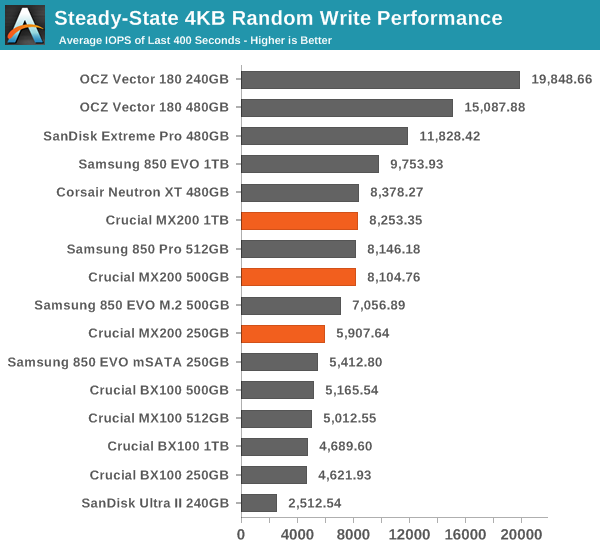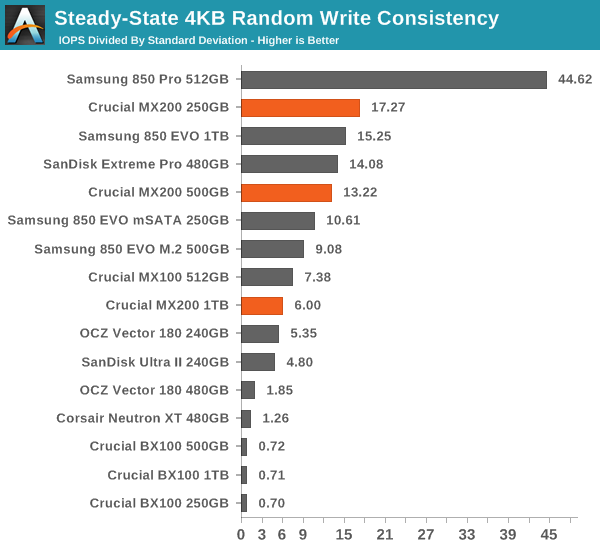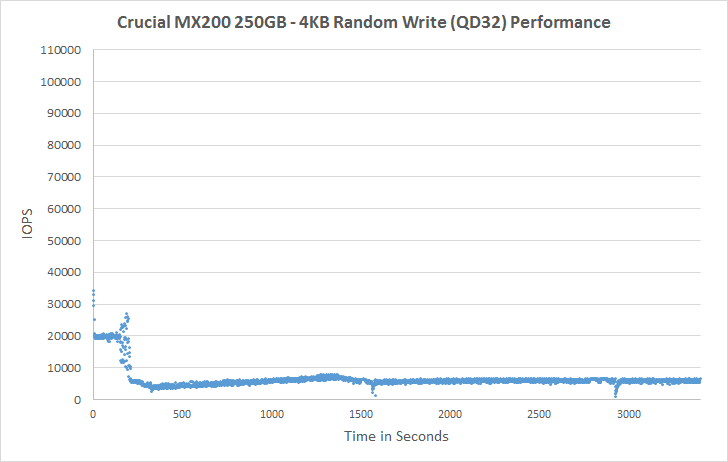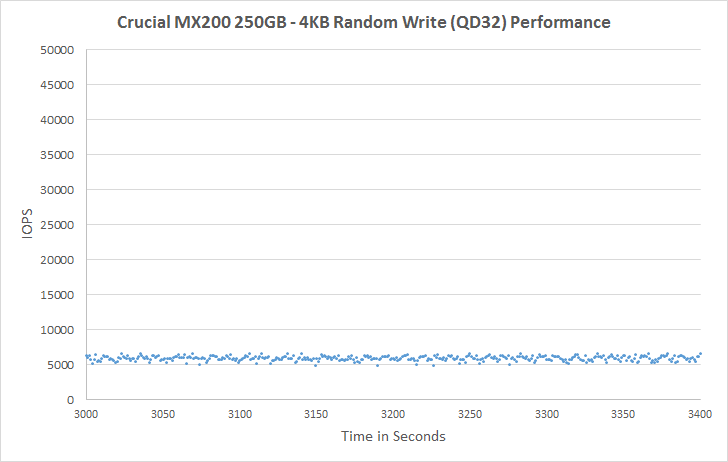Crucial MX200 (250GB, 500GB & 1TB) SSD Review
by Kristian Vättö on May 22, 2015 8:00 AM EST- Posted in
- Storage
- SSDs
- Crucial
- MX200
- Micron 16nm
Performance Consistency
We've been looking at performance consistency since the Intel SSD DC S3700 review in late 2012 and it has become one of the cornerstones of our SSD reviews. Back in the days many SSD vendors were only focusing on high peak performance, which unfortunately came at the cost of sustained performance. In other words, the drives would push high IOPS in certain synthetic scenarios to provide nice marketing numbers, but as soon as you pushed the drive for more than a few minutes you could easily run into hiccups caused by poor performance consistency.
Once we started exploring IO consistency, nearly all SSD manufacturers made a move to improve consistency and for the 2015 suite, I haven't made any significant changes to the methodology we use to test IO consistency. The biggest change is the move from VDBench to Iometer 1.1.0 as the benchmarking software and I've also extended the test from 2000 seconds to a full hour to ensure that all drives hit steady-state during the test.
For better readability, I now provide bar graphs with the first one being an average IOPS of the last 400 seconds and the second graph displaying the IOPS divided by standard deviation during the same period. Average IOPS provides a quick look into overall performance, but it can easily hide bad consistency, so looking at standard deviation is necessary for a complete look into consistency.
I'm still providing the same scatter graphs too, of course. However, I decided to dump the logarithmic graphs and go linear-only since logarithmic graphs aren't as accurate and can be hard to interpret for those who aren't familiar with them. I provide two graphs: one that includes the whole duration of the test and another that focuses on the last 400 seconds of the test to get a better scope into steady-state performance.

It looks like Crucial has finally taken steps to improve steady-state performance, although the additional over-provisioning is partially to thank for the increase. One criticism I always had about Crucial's SSDs was the relatively bad steady-state performance, but the MX200 finally brings the performance closer to other high-end drives.

The consistency is very good as well and far better than what the BX100 offers.
 |
|||||||||
The IO consistency appears to behave differently from the MX100 and the graph resembles 850 EVO and Pro quite a bit by dropping quickly in performance and then slowly increasing before evening out. The 1TB model is an exception, though, as it seems that the firmware can't properly handle such a large capacity, which results in worse performance and considerably higher variation. Unfortunately, the MX200 wouldn't respond to the hdparm command that I use for over-provisioning testing, so I don't have any results with added over-provisioning at this point.
 |
|||||||||










62 Comments
View All Comments
jonovw - Saturday, May 23, 2015 - link
When I got mine, the MX200 was pretty reasonably priced compared to it's competition for a M.2 SATA drive.MrMilli - Saturday, May 23, 2015 - link
"Another thing I'm not very satisfied with is the Dynamic Write Acceleration. I don't think an SLC cache is very useful in an MLC based drive because the performance benefits are marginal, at least with SATA 6Gbps."Sandisk showed with the Ultra II that SLC caching doesn't have to mean terrible latency if implemented correctly.
As a cheap drive, the ARC 100 is looking better every day. For typical desktop workloads, it 'feels' the fastest thanks to it's low latency. I don't understand why it's not recommended more often.
MrSpadge - Saturday, May 23, 2015 - link
I looks like Crucial should really tune their algorithm. Very short bursty writes, which still fit into the DRAM cache, can easily be written in MLC mode. There's enough time for time. Longer bursts could / should be written as SLC, if enough drive space is available. Otherwise MLC mode would be better, if it's likely the data would have to be reorganized soon anyway. Which also happens under long sustained writes, where there's a point where the drive should switch from SLC to MLC mode.Johnny Five - Saturday, May 23, 2015 - link
Well, going back to when SSD's were becoming all the rage and OCZ was having all their problems with their controllers, etc.... Crucial was one of the most consistently reliable and dependable SSD's in the market....... I have consistently used my 4 m4 series 128 GB SSD's for nearly 5 years without not 1 single problem, and have used (2) m550's or several years with no problems........reliability is what makes me keep returning to a certain vendor,, be it motherboard, memory, videocard, HDD, etc....so far my MX200 250 GB SSD is working just as great as my old C300 or m4's are doing.... lets hope that this MX200 lasts at least 3 to 4 years with no problems.... something I can not say for SSD's made by OCZ, Intel, Samsung, or HD's like Western digital, Seagate, Toshiba, Maxtor.......... ( am hoping that Western Digital HD's get better now that they bought out Hitachi........ I have over 18 hitachi Hard Drives ranging from 14 yrs old to 2 yrs old, and have yet to have one brick on me, like most every other brand has...... )
regarding TRIM and SSD degrading performance.......... after 5 years +/- continuous use of my Crucial m4 series SSD's ...... running test via AIDA64 Extreme Edition software, I am still running around 98.7 + % performance level, hopefully this MX200 will run just as good....
Impulses - Wednesday, May 27, 2015 - link
Crucial's had it's rash of firmware issues like anybody else...fokka - Saturday, May 23, 2015 - link
i didn't expect the bx100 to stay that competitive, i guess it's the drive to get right now, especially in a mobile setup where power draw matters.Harry Lloyd - Saturday, May 23, 2015 - link
I want a 512 GB drive with MX100/200 performance for about 100 $. Possible next year (3D NAND or something)?Ramon Zarat - Saturday, May 23, 2015 - link
I'm glad my 2 X Crucial M4 128GB in RAID0 are *STILL* king in 99.999% of my desktop scenarios. over 3 1/2 years now, and not as single issue. Still pumping ~900MB/s in sequential read, even at 75% full! Diskinfo reports them at 97% good. At this rate, they will last me well over 50 years before reaching 50% degradation!hrrmph - Saturday, May 23, 2015 - link
It's good to see AT posting critical reviews (where deserved) again.It's also good to see innovative thinking again, such as the call for the industry to benchmark SSDs at lower queue depths. I would like to read more on the low queue depth issues and which client machines / users are able to push above 1 or 2 QD (if any) and under what circumstances.
philipma1957 - Sunday, May 24, 2015 - link
It would be nice if either crucial or samsung would make larger ssd's in a 2.5 inch form factor.a 1.5tb or 2tb ssd gives me an all ssd system while a 1tb ssd gives me the need for a second drive.
Instead of the little tweaks here and there. Like this one (MX200) which seems to me a fail gives us the size increase. How many years since the first 1tb ssd from crucial (listed 960gb)